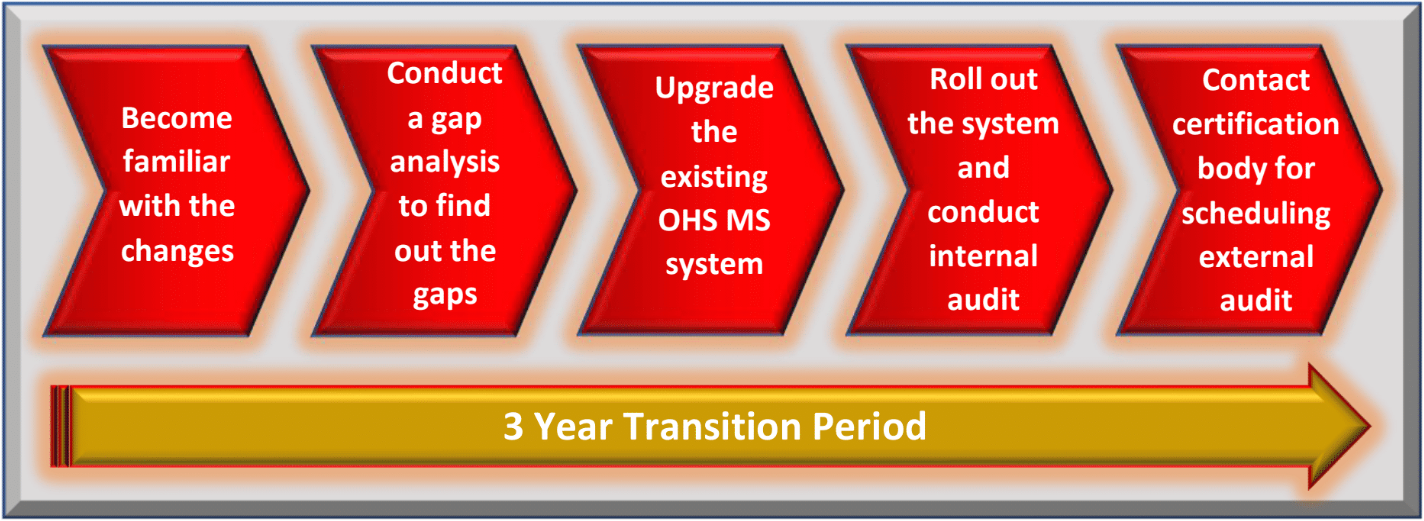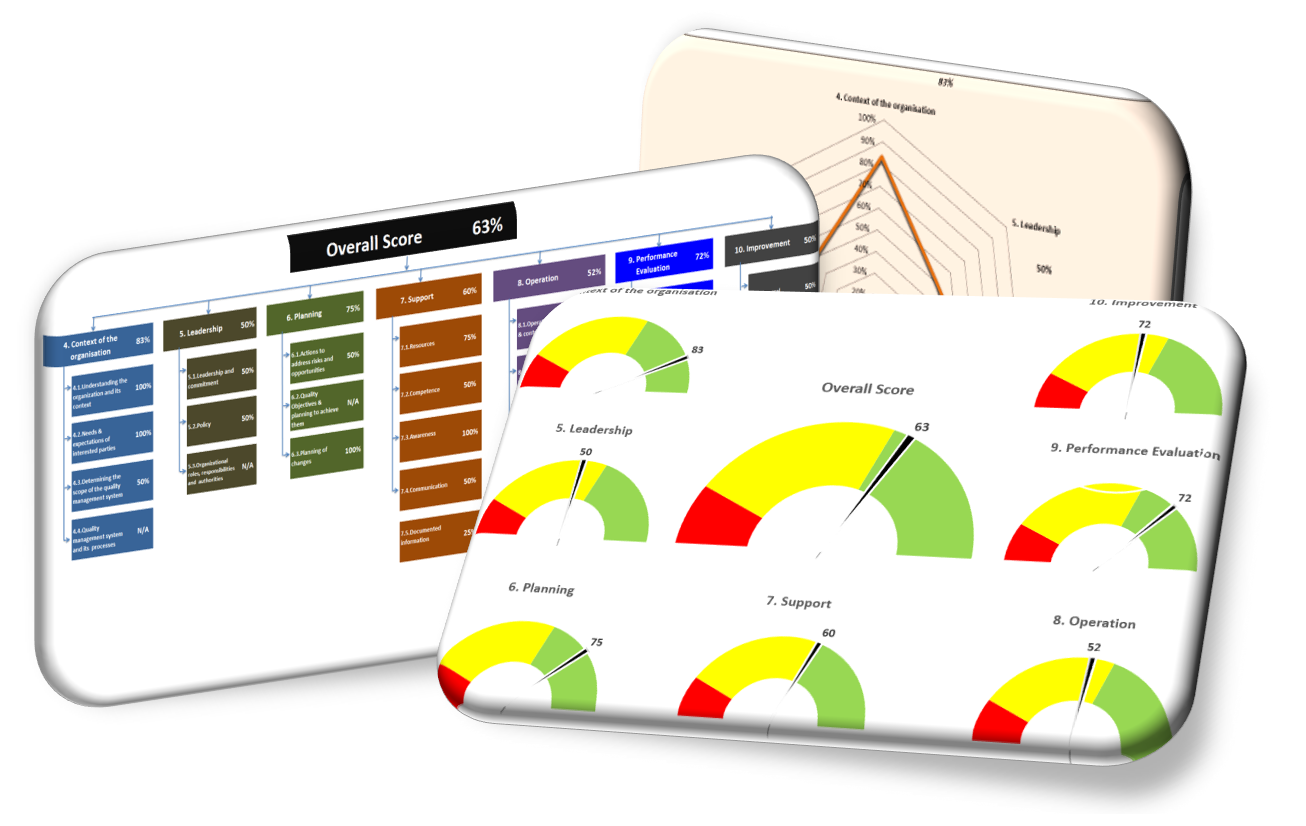Introduction
ISO 45001, the world’s most anticipated standard for workplace health and safety (WHS) systems was published on 12 March 2018. This new Occupational Health and Safety (OHS) Management System standard is aligned with ISO 9001:2015 (Quality Management System) and ISO 14001:2015(Environment Management System) which have been designed based on High Level Structure (HLS). ISO 45001:2018 has been designed as an international standard which has been published by International Organisation for Standardisation (ISO) to replace the existing standards such as OHSAS 18001:2007.
In developing the standard, consideration has been given to the content of other international standards (such as OHSAS 18001 or the International Labour Organisation’s “ILO–OSH Guidelines”) and national standards (such as AS/NZS 4801), as well as to the ILO’s International Labour standards and conventions (ILSs).
OHSAS 18001 and most likely AS/NZS 4801:2001 will be withdrawn after the publication of ISO 45001. Organisations that are currently certified to OHSAS 18001 and/or AS/NZS 4801 will have a three-year window to upgrade their existing certificate to ISO 45001.
So, if your organisation is considering implementing this new standard, a useful starting point is to complete a gap assessment. It will help you understand which areas you already meet and where you will need to implement new approaches or activity to address the requirements. If your organisation is already certified to AS/NZS 4801:2001 and/or OHSAS 18001:2007, the gap assessment will also help you to understand the gaps and how to address them to upgrade your existing OHS system to a ISO 45001 compliant one.
Benefits of implementing ISO 45001
Implementing an ISO 45001-based OH&S management system will enable an organisation to improve its OH&S performance by
- Establishing systematic processes to consider the context of the organisation and its risks and opportunities,
- Being recognised for having achieved an international benchmark,
- Evaluating its OH&S performance and improving it, through taking appropriate actions,
- Developing and implementing an OH&S policy, objectives and targets,
- Developing a systematic approach for the OHS and other risks to eliminate or minimise them through operational control,
- Improving its ability to identify the relevant legislation and reducing the risk of non-compliance with them and the associated costs,
- Reducing the risk of work-related incidents and diseases and their associated costs and insurance premiums,
- Engaging employees more actively through consultation, communication, awareness and training,
- Increasing employee satisfaction and motivation.
Major differences with OHSAS 18001 and AS/NZS 4801
There are many minor differences in the content of ISO 45001 compared to OHSAS 18001 and AS/NZS 4801, but the major differences can be summarised as:
- New structure based on the High-Level Structure (HLS) for easier integration with other management system standards such as ISO 9001:2015, ISO 14001:2015, ISO 27001:2013
- Stronger focus on organisational context and understanding needs and expectations of interested parties as a combination of both internal and external factors regarding health and safety management
- Stronger emphasis on leadership to ensure the OHS matters is integrated with the business strategies and day-to-day activities.
- Stronger emphasis on worker participation and engagement in every aspect of the OHS management system
- Absence of a need for a specific health and safety management representative to ensure that the ownership of the OHS management system is not
- A need for two-way communication with internal and external stakeholders
- Enabling an organisation to integrate other aspects of health and safety, such as worker wellness/wellbeing
- Introducing risk management approach and risk /opportunity concept for the management system itself in addition to operational occupational health and safety hazards and their associated risks
- A requirement for outsourced operations to use the parent’s company health and safety standard.
In the next section, the three OHS standards have been compared clause-by-clause in the comparison table.
ISO 45001 Vs. AS 4801 Vs OHSAS 18001
| AS/NZS 4801:2001 | OHSAS 18001:2007 | ISO 45001:2018 |
|---|---|---|
| 0. Introduction | 0. Introduction | |
| 1. Scope | 1. Scope | 1. Scope |
| 2. Referenced Reference | 2. Normative Reference | 2. Normative reference |
| 3. Definitions | 3. Terms and Definitions | 3. Terms and definitions |
|
4. OHSMS Requirements
|
4. OH&S Management Systems
|
4. Context of the organisation |
| 4.1. Understanding the organisation and its context | ||
| 4.2. Understanding the needs and expectations of interested parties | ||
|
4.1. General Requirements
|
4.1. General Requirements
|
4.3. Determining the scope of OH&S management system |
| 4.4. OH&S management system | ||
| 10.3. Continual improvement | ||
| 5.1. Leadership and Commitment | ||
| 4.2. OH&S Policy | 4.2. OH&S Policy | 5.2. OH&S Policy |
|
4.3. Planning
|
4.3. Planning
|
6.1. Actions to address risks and opportunities |
| 6.1.1. General | ||
|
4.3.1. Planning identification of hazards, hazard/risk assessment and control of hazards
|
4.3.1. Hazard identification, risk assessment and determining controls
|
6.1.2. Hazard Identification and assessment of risks and opportunities |
| 6.1.4. Planning action | ||
| 4.3.2. Legal and other requirements | 4.3.2. Legal and other requirements | 6.1.3. Determination of legal requirements and other requirements |
| 4.3.3. Objectives and Targets |
4.3.3. Objectives and programme(s)
|
6.2.1. OH&S objectives |
| 4.3.4.OHS management plans | 6.2.2. Planning to achieve OH&S objectives | |
|
4.4. Implementation
|
4.4. Implementation and operation
|
7. Support |
| 8. Operation | ||
| 4.4.1. Structure and Responsibility |
4.4.1. Resources, roles, responsibility, accountability and authority
|
5.3. Organisational roles, responsibilities and authorities |
| 4.4.1.1. Resources | 7.1. Resources | |
| 4.4.1.2. Responsibility and accountability | 5.3. Organisational roles, responsibilities and authorities | |
|
4.4.2. Training and competency
|
4.4.2. Competence, Training and Awareness
|
7.2. Competence |
| 7.3. Awareness | ||
| 4.4.3 Consultation, communication and reporting |
4.4.3. Communication, participation and consultation
|
5.4. Consultation and participation of workers
|
| 4.4.3.1 Consultation | ||
| 4.4.3.2 Communication |
7.4. Communication
|
|
| 4.4.3.3 Reporting | ||
|
4.4.4. Documentation
|
4.4.4. Documentation
|
7.5. Documented information |
| 7.5.1. General | ||
|
4.4.5 Document and data control
|
4.4.5. Control of documents
|
7.5.2. Creating and updating |
| 7.5.3. Control of documented information | ||
|
4.4.6 Hazard identification, hazard/risk assessment and control of hazards/risks
|
4.4.6. Operational Control
|
8.1. Operational planning and control |
| 8.1.1. General | ||
| 8.1.2. Eliminating hazards and reducing OH&S risks | ||
| 8.1.3. Management of Change | ||
| 8.1.4. Procurement | ||
| 4.4.7. Emergency Preparedness and Response | 4.4.7. Emergency Preparedness and Response | 8.2. Emergency preparedness and response |
| 4.5.1 Monitoring and measurement | 4.5. Checking | 9. Performance evaluation |
| 4.5.1. Performance measurement and monitoring | 9.1. Monitoring, measurement, analysis and performance evaluation | |
| 4.5.1.1. General | 9.1.1. General | |
| 4.5.1.2 Health surveillance | ||
| 4.5.2. Evaluation of Compliance | 9.1.2. Evaluation of compliance | |
|
4.5.2 Incident investigation, corrective and preventive action
|
4.5.3. Incident investigation, nonconformity, corrective action and preventive action |
10.2. Incident, nonconformity and corrective action
|
| 4.5.3.1. Incident Investigation | ||
| 4.5.3.2. Nonconformity, corrective and preventive action | ||
| 4.5.3 Records and records management | 4.5.4. Control of Records | 7.5.3. Control of documented information |
| 4.5.4 OHSMS audit | 4.5.5. Internal Audit | 9.2. Internal Audit |
| 4.6. Management Review | 4.6. Management Review | 9.3. Management review |
| 10. Improvement |
The Transition Approach
As there is a three-year transition period for replacing OHSAS 18001 and AS/NZS 4801 with ISO 45001, if you are already certified to the current OHS standard, it is good timing for upgrading your system to ISO 45001, but if you have not achieved any OHS certificate so far, you can design your OHS management system based on the high-level structure and get certified to ISO 45001:2018 as soon as certification bodies become authorised to issue the ISO 45001:2018 certificate.
As a best practice approach, you may follow the following step-by-step phases.

How ISO Consulting Services can help you
We have designed our exclusive gap assessment tool which provides you not only the gaps and the area where you need to improve but also numerical and graphical analysis of your current compliance score and how you can increase your compliance level.

Please fill out the Questionnaire or contact us if you need our hands to assist you in developing and establishing your management system in compliance with the requirements of ISO 45001:2018 standard. We also offer a gap assessment service to find out how close you are to your ISO 45001:2018 certificate.
Our expertise is to help our clients develop, implement, certify and maintain their management system through a hassle-free process and with a…
Read MoreThe National Disability Insurance Scheme (NDIS) provides about 460,000 Australians under the age of 65 with a permanent and significant disability with…
Read MoreAs the aged population is growing in Australia, the need for a range of care, accommodation, hospitality, and other services is undeniable. To address this growth…
Read More








